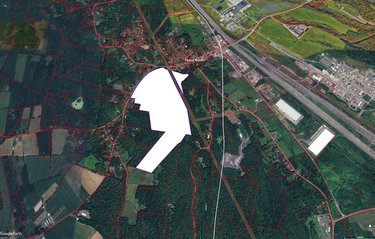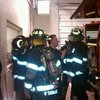Strong opposition to proposed Feura Bush battery storage facility
NEW SCOTLAND — Residents came out in force on Oct. 7, firing against a proposed battery energy storage system on Wormer Road land owned by Councilman Adam Greenberg — and once that particular application comes up for a public hearing, it’s likely they will again.
However, Tuesday’s hearing was on a large-scale energy storage facility currently before the New Scotland Planning Board — a request from RIC Energy to place an 11,300-square-foot, five-megawatt BESS on seven acres at 1543 Indian Fields Road, the 137-acre home of the New Scotland Beagle Club.
The standing-room-only public hearing on Oct. 7 saw over two dozen residents voice nearly unanimous opposition to the proposal.
Most speakers had legitimate concerns about the project — safety issues centering on fires or system failures, which are issues that had been brought up repeatedly by the planning board since the facility was first proposed in July.
The board has asked RIC to address those issues, which the company has to the greatest extent possible.
The town, in response to the pushback, has reposted the entire application and supporting materials online as well as posting a link to a webinar about BESS.
The Oct. 7 hearing took on a similar politically-tinged tone to one years ago when the town, which has been run by Democrats for what is now decades, was updating its hamlet master plan.
The very first speaker on Oct. 7 came out against Greenberg’s proposal, which wasn’t the subject of the hearing. A Democrat, Greenberg is up for re-election in November. Later in the meeting, appointed and un-elected planning board members were told residents would “express our concern about” the proposal at the ballot box in November.
The sentiment felt rammed home as speakers effectively articulated, while they loved the Beagle Club and totally respected its rights as a property owner, they felt since they, the public, were uninformed — in that they, as residents of New Scotland, hadn’t known about the proposal or three previous board meetings on the matter — that the project shouldn’t be built.
RIC said in a statement to The Enterprise that, “We were genuinely impressed by the community’s involvement and the way residents supported one another throughout the hearing. However, some of the concerns were not based on current designs or the information on record. We’re committed to answering every question fully and transparently, and we believe that with a careful review of the facts and our forthcoming responses, concerns will be addressed, and the project can operate safely and quietly.
“Throughout the process, together with our experts at ESRG, we have taken proactive steps to provide information about the technology behind the Battery Energy Storage System (BESS). We’ve hosted informational sessions, met with the fire department, and made technical experts available to explain how the system works and why it’s safe. The project complies fully with all applicable local, state, and federal BESS regulations, including fire safety standards and environmental guidelines.
“In addition, ESRG [Energy Safety Response Group] has worked diligently to clarify misconceptions and dispel misinformation—particularly around the risk of BESS fires—by sharing verified data, safety protocols, and real-world performance metrics. Our goal has always been to foster understanding and trust, and we remain committed to transparency and collaboration as the project moves forward.”
For its part, the planning board kept the public hearing open to allow for more resident input.
Safety
A large portion of RIC’s pre-public-comment presentation revolved around safety, for which it brought in consultant Eric Wood of the Energy Safety Response Group to address concerns. Wood’s background as a firefighter for two decades in addition to another six years spent working in a laboratory where he conducted over 300 medium and large-scale destructive tests on lithium-ion batteries have been trumpeted by RIC since the start of the project.
Throughout his presentation, Wood stressed the multiple layers of safety standards the Tesla Mega Pac 2XL units (the name and maker of the actual BESS being proposed) must adhere to along with the advanced 24-7 monitoring systems that will be employed as part of the project.
Wood said the systems must abide by the New York State Fire Code and standards dictated by the National Fire Protection Association and Underwriters Laboratory. He also noted that New York requires additional safety measures beyond what many other states mandate, including:
— Fire notification and constant monitoring of the Battery Management System, which Wood said provides early notification of an incident before it reaches a thermal runaway event;
— Closed-circuit TV and fire alarm central station monitoring;
— Mandatory annual firefighter training, which can be in-house or provided by outside experts. In the case of New Scotland, RIC’s Emergency Response Plan has already committed ESRG to providing; and
— Required third-party review and inspections conducted during the operational life of the system.
On the BESS design, Wood said the batteries are “non-enterable,” meaning personnel cannot walk inside them. The open-air design limits gas buildup and contrasts sharply with older, enclosed designs that were stacked within buildings, such as the Moss Landing facility, Wood said, while also noting that Moss Landing was 186 times larger than what’s proposed for Indian Fields Road.
While he may not have set anyone in the crowd at ease when he began speaking about contamination and toxic fallout, Wood said that the smoke from a BESS fire is “no worse or any different than what we see from a residential house fire,” and that water runoff testing has shown it to be below EPA and Resource Conservation and Recovery Act standards.
The public hearing
During the Oct. 7 public hearing, Erica Smith was the first resident to speak.
Smith said, “So I think what needs to be disclosed first is that the property is owned by Adam Greenberg, who is a council member.”
Chairman Jeffery Baker responded, “Uh, let me interrupt you. That is not this project.”
Smith said, “Indian Fields Road is not Adam Greenberg?”
Baker responded, “No.”
Smith said, “OK, well then.”
Baker said, “That's a different project that is not ready for review yet.”
Smith said, “All right. Well, then when I come back later I will talk about that. All right. Well still it doesn’t matter.”
Smith continued, “I think first, we need to talk about the fact that we have a lot of different energy projects going on in the town right now,” she said, “and when we start to look at them and break them down, we’re not really prepared for them.”
She said, “And you’re putting all these in here, and you’re saying [firefighters] are getting four hours of fire training. We are relying on volunteer firefighters. We can’t tell if Guilderland is going to do it,” referring to which department would respond to a call at the site. “We can’t tell if Onesquethaw — Onesquethaw has already stated on record, they do not have the training. Do we even have the water supplies?”
Onesquethaw has already received training from ESRG.
Smith was told the town knows which department would respond and that a half-dozen other departments had been contacted and offered the chance to comment on the project.
Smith then drew a line from a project that roiled the town for years to today.
“And then actually, I think back to what I’ve heard: no big box. You’re having multinational, international corporations come in here and overdevelop our town and make it industrial,” she said. “You didn’t want big box stores, and now we’re going to industrialize it?”
David Ritz fired off a number of technical concerns.
“You’re talking about remote sensors. Where is it being staffed? Fiber optics lines get cut every day,” Ritz said. “Is there a dead-man switch on-site? Is there an internal protocol where, if you start to see a thermal runaway and there’s not a reaction from your help desk, there’s an on-site system that shuts everything down and goes cold? What’s your redundancy for sensors? Do you triple redundant? Do you even have double? Single? Is there any requirement?”
Chairman Jeffrey Baker told Ritz that the board had raised those issues with RIC.
“Asking is great, Ritz responded, “but the correct answers are better.”
Rich Brown and Jess Sardella felt that the fix was already in.
“I love the expressions on your faces as these are going on. I wish I could videotape this because you guys have made your decisions,” Brown told planning board members. “So it’s up to us to at least let you know why it’s a bad one … In your mind, when I look at you and I hear you, you’ve made your decision.”
Sardella said, “The very convenient and questionable timeline between developers approaching the town for potential sites and then this town law was just up and abruptly adopted.”
Supervisor Doug LaGrange told The Enterprise on Oct. 13 that the town was approached in late 2022, early 2023 by a company looking to install a BESS.
“We wanted to be proactive like some other communities have been and have something that was as thorough as possible,” LaGrange said of the town drafting and adopting a BESS law, which New Scotland has had in place for well over a year. There have been communities that have adopted moratoriums, he said, but that’s “because they didn’t have a law” on the books.
New Scotland began getting its regulatory ducks in a row in December 2023 because it had been “been approached by a couple of possible projects,” LaGrange said at the time. With Local Law E of 2023, LaGrange said in December 2023, New Scotland was looking to provide a framework “for the designation of properties suitable for the location, construction, and operation of battery energy storage systems.” Then, over the course of a number of documented months, the town refined the proposed law, ultimately adopting it in May 2024.
“We would have considered a moratorium,” LaGrange said on Oct. 13, “but we got out in front of it.”
“Now we’ve already got a couple of petitions in place here for planning board approval,” Sardella said during the Oct. 7 public hearing. “At the least, it looks suspicious, right? That’s concerning, and I think many of the people in this room feel that. That’s why they came here tonight to voice their concerns.”
The first meeting held on a BESS project seeking approval was RIC’s in July, 15 months after the adoption of Local Law E of 2023.
Sardella then said she was “circulating a petition requesting a 12-month moratorium, and I believe that, as residents of the town, you have concerns as well, right? And that you want a safe and sustainable place to raise your family. I just, I would ask that you listen to everyone’s concerns and perhaps do what you can and do what is necessary to do right by the community that you serve that elected to put you in these seats.”
Planning board members, which held open the Oct. 7 public hearing, are appointed, not elected.
Sardella, who chairs the New Scotland Republican Party, presented the petition to the town board the following night. Of the nearly 40 signatures, at least three were registered Democrats. Error-riddled moratorium language submitted on New Scotland GOP masthead falsely claims “the law was shaped” to benefit Adam Greenberg.



Hi Sean,
At last Tuesday night's New Scotland Planning Board meeting, the Beagle Club's fire safety training expert, Eric Wood, mentioned briefly "firefighter reach-backs." I've never heard or read "firefighter reach packaging," which the article mentions at least in the draft on-line today, discussed in the context of BESS or the Beagle Club application. Firefighter reach-backs describe the requirement that the BESS operator let the local fire department know whenever there is an excursion beyond the normal operating envelope of conditions that prevent a fire, even when no fire developed and no response from the fire department was called for. Such notifications are very valuable. As far as I can see, only people who write and read fire safety regulations call such notifications firefighter reach-backs, so it's confusing, I admit. I had to ask Eric this question after the meeting or I wouldn't know.
The term "firefighter reach packaging" concerns something also important, but unrelated: the response to when there's been an injury at the scene of a fire.
Thanks for this coverage of what was a very rich meeting raising many important concerns.